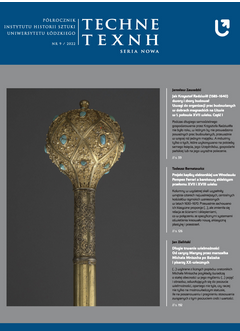Projekt kaplicy elektorskiej we Wrocławiu Pompeo Ferrari a barokowy eklektyzm przełomu XVII i XVIII wieku
Design of the Elector’s Chapel in Wroclaw Pompeo Ferrari and the Baroque eclecticism at the turn of the 17th and 18th centuries
Author(s): Tadeusz BernatowiczSubject(s): Cultural history, Architecture, 17th Century, 18th Century
Published by: Wydawnictwo Uniwersytetu Łódzkiego
Keywords: Pompeo Ferrari; 18th century; baroque architecture; Elector’s Chapel (Wroclaw); Gianlorenzo Bernini; Carlo Fontana; Academy of St. Luke (Rome); architectural designs;
Summary/Abstract: Pompeo Ferrari’s earliest work in Poland was the design of the Elector’s Chapel at the cathedral in Wroclaw, made in 1704. We know of two drawings showing a longitudinal cross-section, allowing reconstruction and identification of the genesis of the architectural and sculptural forms. The architect, a two-time winner of the St. Luke’s Academy competitions, designed a work reflecting the currently prevailing concepts of Baroque eclecticism in Rome. These consisted in combining in one work the aclassical forms created by architects of the mature Baroque period (P. da Cortona, G.L. Bernini. F. Borromini, A. Pozzo and C. Rainaldi) with classical forms defined by Renaissance and early Baroque architects and the ancient tradition. These processes were strongly manifested in the teaching at St. Luke’s Academy – examples are the 1694 competition and the prize for A. Sperone (Speroni) or the 1696 competition and the designs of A. Rossini, L. Rusconi-Sassi and B. Spinelli. At the same time, in the fourth quarter of the 17th century, chapels and churches with eclectic Baroque features were being built in Rome. Attempts to combine elements of the language of these two traditions can be seen on the Wroclaw project. It features a classical Renaissance structure of architectural orders, combined with an onion-shaped dome, a dynamic colonnade with bulging elements of the entablature. In the design of the altarpiece we find motifs from the works of Bernini, Borromini and Carlo Fontana, the most important moderator of the eclectic approach in architectural design. Although not realized, Ferrari’s design was among the earliest examples of the transmission of the latest artistic tendencies in Rome, from which the late Baroque in Central and Eastern Europe evolved.
Journal: TECHNE. Seria Nowa
- Issue Year: 2022
- Issue No: 9
- Page Range: 119-153
- Page Count: 35
- Language: Polish

